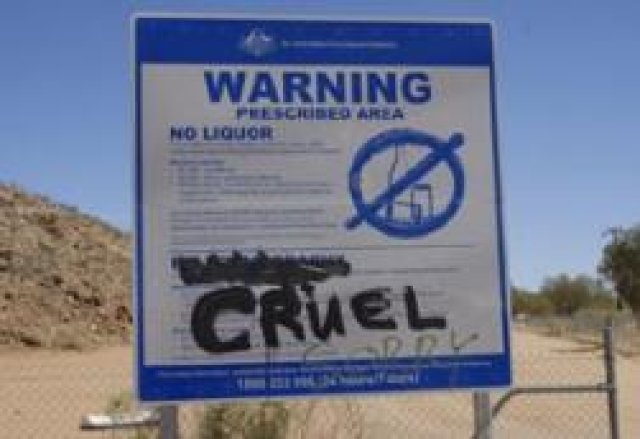
About 80 people gathered on July 28 at the Holiday Inn on Darwin’s Esplanade for one of the federal government’s Stronger Futures “consultations”.
One woman said: “It’s a bit late, mate.”
Stronger Futures is the government’s discussion paper about the future of the Northern Territory intervention, which slashed the rights of Aboriginal people in 2007, many of which have yet to be restored.
This is the second round of consultations Labor has run about the intervention. Labor promised Stronger Futures would be different to the top-down, draconian and heavy-handed way the former Liberal/National government of John Howard rolled out the intervention.
For the June 2009 consultations, Aboriginal people mobilised in large numbers. Most called for an immediate end to the intervention and put forward a raft of concrete proposals to close the gap of disadvantage between Aboriginal and non-Aboriginal Australians.
The government shelved the proposals and misrepresented the meetings, claiming they showed widespread support for the intervention. Independent recordings showed this was a lie: the government selectively quoted from the meetings.
It is this context that Mark Coffey, executive director of the Department of Families, Housing, Community Services and Indigenous Affairs, has organised the current consultation process across the NT.
At the public meeting in Darwin on July 28, he was roasted alive.
The consultations have been extensive — each of the 73 communities affected by the intervention in the NT had one as well as town camps in places such as Alice Springs and Darwin.
At Bagot and Kalkarindji, Aboriginal people mobilised to condemn the government in heated meetings.
At some of the Darwin town camps, locals did not show, either because they did not know about the meetings or thought they would be a waste of time like the last ones.
Stronger Futures lists the highly contested “successes” of the NT intervention and identifies eight areas for discussion. Coffey used a PowerPoint presentation to introduce the discussion points. In every case, Aboriginal people were cast as the “problem” the government was trying to address.
In the area of education, for example, Stronger Futures said school attendance was “non-negotiable” for the government.
The audience in Darwin was vocal in pointing out this implied Aboriginal parents did not believe education was important.
Under a bullet point about “encouraging school attendance”, tying welfare payments to school attendance was the only concrete suggestion made to deal with the problem.
One woman countered that school attendance was a whole of society problem. She condemned the NT government's “First Four Hours policy”, which limits teaching in Aboriginal language to the end of the school day.

She said this policy and the lack of resources in remote communities were the main cause of poor attendance by Aboriginal students.
The Darwin meeting attracted many workers from government and service agencies, many of whom were Aboriginal. Many said the intervention and the policies that followed had made service delivery in Aboriginal communities far more difficult.
Coffey invited constructive suggestions — “what could work?” — but participants pointed out the consultation process was simply reinventing the wheel: programs known to be working before 2007 had their funding cut as part of the rollout of the intervention.
“Government mistakes have generated a great deal of cynicism,” one service worker said. “People have no evidence that things have changed.”
Coffey said the last round of consultations had changed government policy. He said the government had restored the Racial Discrimination Act, which was suspended to allow the intervention to become law in 2007. The room howled in response.
Even if the RDA has been formally reinstated — and some contest this because laws that discriminate against Aboriginal land ownership are still in place — the realities of the intervention fly in the face of the legal niceties.
The “poster child” of the amended, “non-racist” intervention is the new income management scheme. Initially, Aboriginal residents in the 73 targeted communities and all the town camps had half their welfare replaced with a card that could be spent only on food, clothing and medical supplies.
In August last year, the legislation was changed, broadening income management to include the whole community in the NT and selected parts of Australia. In theory, this change also meant people on income management could apply for an exemption.
The Darwin Community Legal Service, however, has found that 94% of people on income management are Aboriginal.
“The damage was done in the first 12 months,” an audience member at the meeting said. “Your role here is to listen to us, not justify [current policy].”
Others condemned the punitive measures directed against alcoholics in Aboriginal communities rather than the grog runners who break rules set up by the communities themselves. A call was made for an inquiry into the role of non-Aboriginal staff bringing alcohol into dry communities.
There was unanimous condemnation of the imposing signs set up outside each of the initially targeted communities and town camps.
“If you want to rebuild trust with these communities you’ve damaged so much,” one woman said, “you can start by removing each of these signs and funding those communities to put up their own welcome signs and their signs banning grog.
“Aboriginal communities did that voluntarily for years before the intervention.”
Coffey said all the recommendations would be taken to government and discussed. The ball is now in the government’s court. Will it listen?
Comments
Anonymous replied on Permalink
Anonymous replied on Permalink